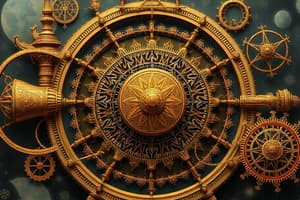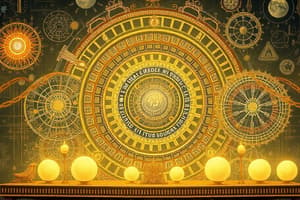Podcast
Questions and Answers
Which fundamental principle states that the total energy of an isolated system remains constant?
Which fundamental principle states that the total energy of an isolated system remains constant?
- Coulomb's law
- Biot-Savart law
- The first law of thermodynamics (correct)
- The second law of thermodynamics
What does the term 'quantization' primarily refer to in the context of modern physics?
What does the term 'quantization' primarily refer to in the context of modern physics?
- The discrete, specific values of energy levels of particles (correct)
- The continuous variation of energy levels
- The increase in entropy over time
- The bending of light when passing through a lens
Which concept is central to describing the motion of objects in a circular path?
Which concept is central to describing the motion of objects in a circular path?
- Internal energy
- Kinetic Energy
- Linear momentum
- Angular momentum and torque (correct)
Which of the following best describes the law that governs the force between electric charges?
Which of the following best describes the law that governs the force between electric charges?
What phenomenon is demonstrated when light bends as it passes from air into water?
What phenomenon is demonstrated when light bends as it passes from air into water?
Which law dictates the direction of heat flow within an isolated system?
Which law dictates the direction of heat flow within an isolated system?
Which phenomenon in modern physics describes the relationship between space and time?
Which phenomenon in modern physics describes the relationship between space and time?
What is the primary focus of studying electromagnetism?
What is the primary focus of studying electromagnetism?
Flashcards
Classical Mechanics
Classical Mechanics
The study of the motion of macroscopic objects, such as planets and cars, using Newton's laws of motion.
Newton's Second Law of Motion (F = ma)
Newton's Second Law of Motion (F = ma)
The fundamental law in classical mechanics that relates force, mass, and acceleration. It states that the force acting on an object is equal to its mass times its acceleration.
Inertia
Inertia
The property of an object to resist changes in its motion. An object at rest will stay at rest, and an object in motion will stay in motion at a constant velocity unless acted upon by an unbalanced force.
Thermodynamics
Thermodynamics
Signup and view all the flashcards
First Law of Thermodynamics
First Law of Thermodynamics
Signup and view all the flashcards
Electromagnetism
Electromagnetism
Signup and view all the flashcards
Optics
Optics
Signup and view all the flashcards
Quantum Mechanics
Quantum Mechanics
Signup and view all the flashcards
Study Notes
Classical Mechanics
- Classical mechanics describes the motion of macroscopic objects, from planets to cars, using Newton's laws of motion.
- Newton's laws relate force, mass, and acceleration: F = ma.
- Concepts like inertia, momentum, and energy are central to the study.
- Different types of forces exist, including gravitational, electromagnetic, and frictional forces.
- Applications of classical mechanics include calculating trajectories, predicting collisions, and analyzing mechanical systems.
- Rotational motion is described by angular momentum and torque.
Thermodynamics
- Thermodynamics deals with heat, work, and the relationships between them.
- Key concepts include temperature, entropy, and internal energy.
- The laws of thermodynamics govern the direction of heat flow and the efficiency of heat engines.
- The first law of thermodynamics states that energy cannot be created or destroyed, only transferred or changed from one form to another.
- The second law of thermodynamics states that the total entropy of an isolated system can only increase over time.
- Thermodynamics is important in various applications including power generation, refrigeration, and chemical reactions.
Electromagnetism
- Electromagnetism describes the interactions between electric charges and magnetic fields.
- Electric forces are described by Coulomb's law.
- Magnetic forces are described by Biot-Savart's law.
- Electric fields and magnetic fields can create forces on moving charges.
- Electromagnetic waves, like light and radio waves, travel at the speed of light.
- Applications include electrical circuits, motors, and communication technologies.
Optics
- Optics deals with the behavior of light.
- Light can be described as waves or particles (photons).
- Reflection and refraction of light are important concepts.
- Mirrors and lenses manipulate light to produce images.
- Optical instruments, like microscopes and telescopes, use lenses and mirrors to magnify or focus images.
- Types of optical phenomena include rainbows and mirages.
Modern Physics
- Modern physics builds upon classical physics but introduces new phenomena at the atomic and subatomic levels.
- Special relativity describes the relationship between space and time.
- General relativity describes gravity as a curvature of spacetime.
- Quantum mechanics describes the behavior of matter at the atomic and subatomic levels, with concepts such as wave-particle duality and quantization.
- Important discoveries include the photoelectric effect, and the Bohr model of the atom.
- Applications of modern physics include nuclear power, lasers, and semiconductors.
Studying That Suits You
Use AI to generate personalized quizzes and flashcards to suit your learning preferences.




